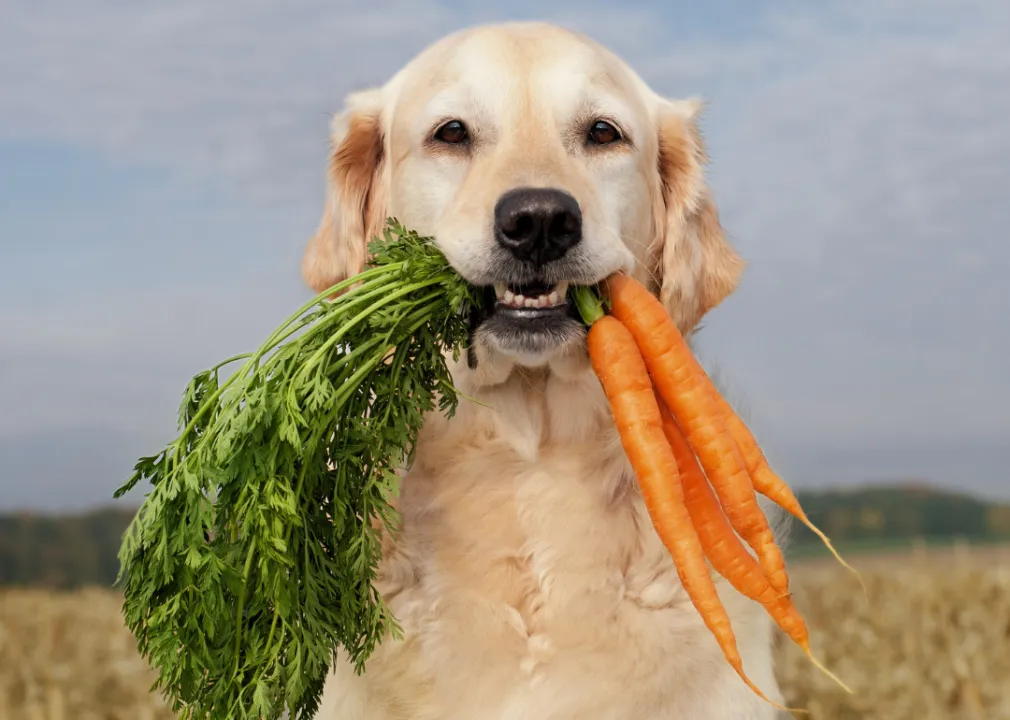The history of dog food and nutrition, from hunting to the raw food movement
Pets

Audio By Carbonatix
By Colleen Kilday, Stacker

The history of dog food and nutrition, from hunting to the raw food movement
Compared to the projected $82 billion dog food market Hypercube Insights forecasts by 2026, the origins of the domesticated dog's diet are quite humble.
Around 20,000 years ago, early hunter-gatherers, hoping to spare themselves from the consequences of excess protein consumption, such as diarrhea and protein poisoning, would give wolves spare scraps of meat. The practice not only laid the groundwork for dog nutrition and today's pet food industry but may have even played a pivotal role in the domestication of dogs themselves.
Ollie looked at news articles, research journals, and historical sources to outline the major milestones in the history of dog food and nutrition.
The nutritional needs of dogs began diverging from those of their wolf ancestors due to genetic changes that allow modern dogs to digest starches much more efficiently. The shift paralleled advances in agriculture and dog domestication. The development of these starch-digesting genes mirrors similar changes in human populations who began consuming higher carbohydrate diets due to agriculture. Still, up to this point, dogs' diets primarily consisted of leftover scraps from their companion's meals, with no regard for specialized needs.
It is difficult to pinpoint precisely when the practice of feeding dogs specialized diets first emerged, as it likely evolved over time. However, the earliest documented recommendation for a specialized canine diet originates over 4,000 years ago in author Marcus Terentius Varro's manual "Farm Topics." The text advises dog owners to feed them scraps of meat and bone and barley bread soaked in milk.
Literature on specialized dog diets could be found among noble families with working and hunting dogs in the Middle Ages. In a 14th-century text, author Gaston III, Count de Foix even details specific foods to give sick dogs, including buttered eggs and goat's milk. However, providing dogs with specialty meals did not transcend classes until the emergence of a more affluent middle class in the 19th century, during the Industrial Revolution.
The first commercial dog food
During that time, American electrician James Spratt embarked on a journey from Ohio to London to make a living selling lightning rods. There, the would-be salesman noticed dogs rummaging around the riverbanks. Realizing the dogs were eating the dry biscuit sailors ate during long voyages called hardtack, he realized there was similarly a need for affordable, convenient, shelf-stable food among dog owners. After many iterations, Spratt formulated the first commercial dog food: Spratt's Patent Meat Fibrine Dog Cakes—a blend of grains, vegetables, beetroot, and "dried unsalted gelatinous parts of Prairie Beef," an ad explained, per The New York Times.
A businessman at heart, Spratt quickly employed a persistent marketing campaign that popularized his product across the country, even including testimonials from the owners of show dogs. From there, he expanded his product line to cater to specific life stages and more: puppy biscuits with cod liver oil for development and different-sized "grade" biscuits for smaller and larger dogs. While Blue Buffalo, a dog food manufacturer owned by General Mills, eventually bought Spratt's in the 1950s, the concept of an affordable, mass-produced dog food persisted well beyond its earliest variant.
Canned meat
Horse meat-packing plant owners and brothers Philip Mitchell, Earl, and Ernst Chappel pioneered the next major innovation in dog food in 1922 when they concocted a blend of grains and meat—specifically, horse meat—into a paste that could be canned and stored long-term. They named the new product Ken-L Ration, which discreetly described its meat contents in a 1950 Toledo Blade ad as "lean, red meat." The product was so successful that, by the 1930s, the company was breeding horses specifically for dog food—a catchy jingle helped sales too.
But to the relief of horses nationwide, the U.S. government began rationing tin and meat amid domestic struggles during World War II, sparking a downturn in the popularity of canned dog food.
The first kibble
Innovations in food processing gave rise to the next major transformation in dog food.
While extrusion, a food processing method, had been used to successfully mass-produce inexpensive cereals and pastas since the 1930s, it was not until the 1950s that extrusion was used to produce pet food as well.
In 1950, Ralston Purina Co. used an extruder, which pushed ingredients through a tube and used high pressure and air to produce Chex cereal. The process helped keep cereal crisp in milk. At the time, the company's pet food division was also fielding complaints about the appearance, texture, and digestibility of its food. This prompted the division to borrow the technology from its cereal colleagues, which resulted in Purina Dog Chow, the first commercial dog kibble.
Establishing standards in pet nutrition
Until that point, dog food was quite unstandardized, according to Dr. Magda Szyrmer, a holistic and integrative vet. There was no governing body to determine standards for nutrition and many claims went unchecked.
The issue prompted the Association of American Feed Control Officials to step in. During its first meeting in the 1960s, AAFCO established definitions for ingredients that, among other things, outlined what was chicken versus what was a chicken by-product and set up what it meant to be "complete and balanced." Their rules continue to be largely in place and claims of being "complete and balanced" are still printed on bags of dog food today.
By the 1970s and '80s, the National Research Council of the National Academies tackled nutritional requirements for dogs and published "Nutrient Requirements of Dogs and Cats," establishing recommended standards for domestic dog nutrition. Interestingly, Szyrmer notes that the council's research wasn't based on dogs or cats but rather "extrapolated from other species."
Modern trends: Increased diversification and sustainability
Diversification is expected to continue within the pet food industry: According to market research company GfK, the number of pet food and treat brands increased 71% between 2011 and 2018.
In addition to more variety, the pet food industry is targeting consumers' belief systems. Some notable trends include minimally processed dog food or "raw" diets marketed as purportedly resembling the domestic dog's natural diet. Air-dried and freeze-dried dog feeds appeal to consumers concerned about maximizing the nutritional value of their dog's food. Gently cooked or baked foods also offer more minimally processed options. Other sustainability-minded dog foods are introducing alternative protein sources like the black soldier fly as well as algae-based products.
Many of these trends are probably already familiar to owners. In fact, Mars Petcare predicts pet food trends by following trends in human food. In a 2018 presentation at the Global Pet Expo, Eric Huston, then the company's marketing director (now general manager at Mars Food Canada), shared that human food trends appear in the pet food arena at a faster rate than before, from 5-6 years historically to as little as a 1.5-2 years.
The speed of change is partly due to an increasingly digital society, where information and purchase choices happen more quickly. Some upcoming trends could include dog probiotics or a specialized appliance for making dog treats at home. No matter the innovation, one thing stays the same: The field of dog nutrition follows human dietary patterns as it did in its infancy—a true reflection of the enduring connection between human and dog.
Story editing by Carren Jao. Copy editing by Paris Close. Photo selection by Ania Antecka.
This story was produced by Ollie (Inc) and was produced and distributed in partnership with Stacker.

























